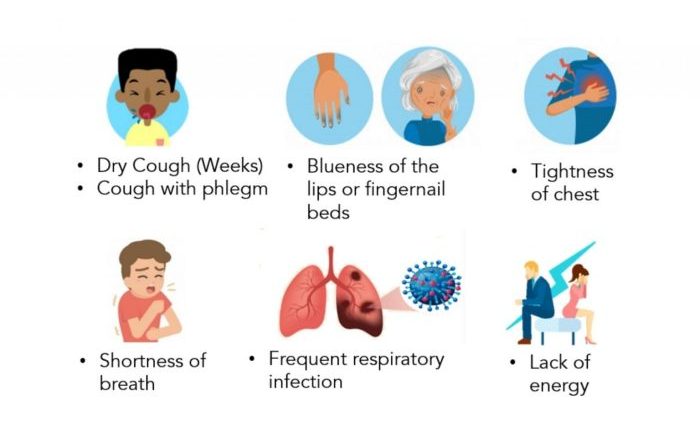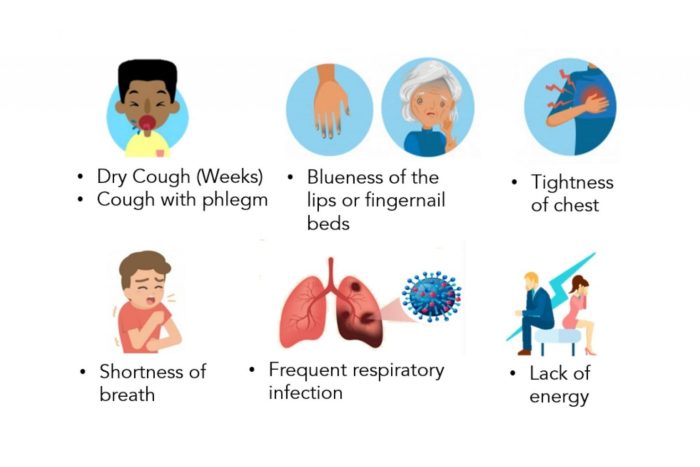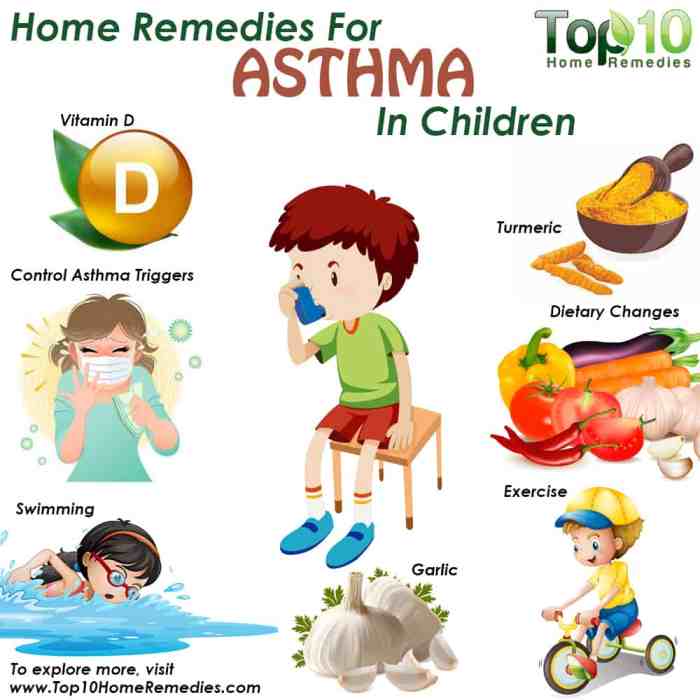
Managing asthma symptoms in children, this guide delves into the various aspects of asthma management in children, offering insights and solutions for parents and caregivers alike.
From understanding the causes to discussing medications and lifestyle changes, this comprehensive overview aims to equip readers with the necessary knowledge to handle asthma symptoms effectively in children.
Causes of asthma in children
Asthma in children can be triggered by various factors, including genetic predisposition and environmental influences. Understanding these causes is crucial in managing and preventing asthma symptoms in children.
Common Triggers for Asthma Symptoms in Children
- Dust mites, pet dander, pollen, and mold: Allergens like these can trigger asthma symptoms in children when inhaled.
- Tobacco smoke: Exposure to secondhand smoke can worsen asthma symptoms and increase the risk of asthma development in children.
- Respiratory infections: Viral infections, such as the common cold, can exacerbate asthma symptoms in children.
Genetics and Asthma Development in Children
Genetics can play a significant role in the development of asthma in children. Children with a family history of asthma or allergies are more likely to develop asthma themselves. Specific genes related to immune responses and airway inflammation are believed to contribute to asthma susceptibility.
Environmental Factors Worsening Asthma Symptoms in Children
- Air pollution: Exposure to pollutants in the air, such as vehicle emissions or industrial fumes, can worsen asthma symptoms in children.
- Indoor air quality: Poor ventilation, high humidity levels, and exposure to allergens indoors can trigger asthma symptoms in children.
- Weather changes: Cold air, high humidity, or sudden temperature changes can also exacerbate asthma symptoms in children.
Diagnosing asthma in children

When it comes to diagnosing asthma in children, it is crucial to pay attention to the signs and symptoms that may indicate the presence of this condition. Early diagnosis is key in effectively managing asthma symptoms and improving the quality of life for children with asthma.
Typical symptoms leading to an asthma diagnosis
- Wheezing: A whistling sound when breathing, particularly during exhalation.
- Coughing: Especially at night or early in the morning, or triggered by physical activity or exposure to allergens.
- Shortness of breath: Difficulty breathing, especially during physical activities or asthma triggers.
- Chest tightness: A sensation of pressure or tightness in the chest.
Tests used to diagnose asthma in children
- Spirometry: This test measures how much air a child can exhale after a deep breath and how quickly they can do it. It helps assess lung function and detect asthma.
- Peak flow measurement: This test measures how fast a child can blow air out of their lungs. It is useful in monitoring asthma and detecting changes in lung function.
- Allergy testing: Identifying specific allergens that trigger asthma symptoms can help in managing the condition effectively.
- Chest X-ray or CT scan: These imaging tests can help rule out other conditions that may present similar symptoms to asthma.
Importance of early diagnosis in managing asthma symptoms in children
Early diagnosis of asthma in children is essential for several reasons, including:
- Preventing severe asthma attacks and complications.
- Starting appropriate treatment early to control symptoms and improve lung function.
- Reducing the risk of asthma-related hospitalizations and emergency room visits.
- Helping children lead an active and healthy lifestyle by effectively managing their asthma symptoms.
Medications for managing asthma symptoms: Managing Asthma Symptoms In Children

Managing asthma symptoms in children often involves the use of various medications to control inflammation and reduce the frequency of asthma attacks. These medications work in different ways to help children breathe easier and improve their quality of life.
Bronchodilators
Bronchodilators are commonly prescribed to children with asthma to help relax the muscles around the airways, making it easier to breathe. These medications come in two forms: short-acting and long-acting. Short-acting bronchodilators provide quick relief during an asthma attack, while long-acting bronchodilators are used for long-term control. Potential side effects of bronchodilators include increased heart rate and jitteriness.
Inhaled Corticosteroids
Inhaled corticosteroids are anti-inflammatory medications that help reduce swelling and mucus production in the airways, making it easier to breathe. These medications are typically used as a long-term control medication to prevent asthma symptoms. Potential side effects of inhaled corticosteroids in children may include oral thrush and a hoarse voice.
Leukotriene Modifiers
Leukotriene modifiers are another type of medication used to manage asthma symptoms in children. These medications work by blocking the action of leukotrienes, which are chemicals in the body that can cause inflammation in the airways. Leukotriene modifiers are often prescribed in addition to other asthma medications. Potential side effects may include headache, nausea, and stomach pain.
Combination Inhalers
Combination inhalers contain both a corticosteroid and a long-acting bronchodilator in one device. These medications are used for long-term asthma control and are often prescribed to children with moderate to severe asthma. Combination inhalers can help improve lung function and reduce asthma symptoms. Potential side effects may include increased risk of thrush and hoarseness.
Lifestyle changes and home remedies
When it comes to managing asthma symptoms in children, lifestyle changes and home remedies play a crucial role in providing relief and improving overall quality of life. By making simple adjustments to the home environment and incorporating certain dietary changes, parents can help their children better manage their asthma condition.
Creating an asthma-friendly home environment for children
Creating an asthma-friendly home environment is essential in reducing triggers and ensuring a safe space for children with asthma. Here are some tips to consider:
- Avoid smoking indoors and ensure a smoke-free environment.
- Keep the house clean and dust-free by regularly vacuuming and dusting.
- Use allergen-proof covers on pillows and mattresses to reduce exposure to dust mites.
- Monitor humidity levels and use a dehumidifier to keep it between 30-50% to prevent mold growth.
- Remove carpets and opt for hardwood or tile flooring to minimize allergens.
Role of diet and nutrition in managing asthma symptoms
Diet and nutrition play a significant role in managing asthma symptoms and improving lung function. Here are some dietary recommendations for children with asthma:
- Incorporate a variety of fruits and vegetables rich in antioxidants such as vitamin C and E to reduce inflammation.
- Avoid foods that may trigger allergies or worsen asthma symptoms, such as dairy, eggs, peanuts, and shellfish.
- Include omega-3 fatty acids found in fish, flaxseeds, and walnuts to reduce airway inflammation.
- Ensure adequate intake of magnesium-rich foods like nuts, seeds, and leafy greens to support lung function.
Effective home remedies for alleviating asthma symptoms in children
In addition to medications prescribed by healthcare providers, certain home remedies can help alleviate asthma symptoms in children. Here are some effective home remedies to consider:
- Steam inhalation with added eucalyptus oil or menthol can help open up airways and ease breathing difficulties.
- Warm drinks such as herbal teas or warm water with honey can help soothe the throat and reduce coughing.
- Practicing relaxation techniques like deep breathing exercises or yoga can help reduce stress and improve lung function.
- Using a saline nasal spray or rinse can help clear nasal passages and reduce congestion.
Emergency preparedness and action plans

Asthma action plans are crucial tools for managing asthma symptoms in children. These plans Artikel specific steps to take in case of an asthma attack, helping caregivers and teachers know how to respond effectively.
Creating an asthma action plan for children
- Work with your child’s healthcare provider to create a personalized asthma action plan.
- The plan should include information about your child’s asthma triggers, medications, and peak flow meter readings.
- Clearly Artikel the steps to take during an asthma attack, including when to use rescue medications.
- Make sure caregivers and teachers have a copy of the action plan and understand how to follow it.
When to seek emergency medical help, Managing asthma symptoms in children
- If your child is experiencing severe breathing difficulties, chest pain, or bluish lips or fingernails, seek emergency medical help immediately.
- Other signs that may require emergency assistance include extreme difficulty speaking, confusion, or a peak flow meter reading that is in the red zone despite using rescue medications.
- It’s important to act quickly and not delay seeking medical attention if your child’s symptoms are worsening rapidly.
Educating caregivers and teachers
- Provide caregivers and teachers with information about your child’s asthma triggers, medications, and specific asthma action plan.
- Ensure they know how to recognize the signs of an asthma attack and how to respond appropriately.
- Emphasize the importance of keeping rescue medications readily available and accessible in case of an emergency.
- Regularly review and update the asthma action plan with caregivers and teachers to ensure they are prepared to manage your child’s asthma symptoms effectively.
Wrap-Up
In conclusion, Managing asthma symptoms in children requires a multi-faceted approach that involves early diagnosis, proper medication, lifestyle adjustments, and emergency preparedness. By staying informed and proactive, caregivers can effectively manage asthma in children and ensure their well-being.
Autoimmune diseases in women are caused by a combination of genetic, environmental, and hormonal factors. Research has shown that women are more prone to developing autoimmune diseases due to their unique immune responses. To learn more about the causes of autoimmune diseases in women, visit Causes of autoimmune diseases in women.
Preventive measures for osteoporosis in men include maintaining a healthy diet rich in calcium and vitamin D, regular weight-bearing exercise, and avoiding smoking and excessive alcohol consumption. These measures can help reduce the risk of developing osteoporosis in men. For more information on preventive measures for osteoporosis in men, check out Preventive measures for osteoporosis in men.
Effective treatments for irritable bowel syndrome (IBS) include dietary changes, stress management techniques, and medications to alleviate symptoms. It is important to work with a healthcare provider to develop a personalized treatment plan for IBS. To learn more about how to treat irritable bowel syndrome, visit How to treat irritable bowel syndrome.